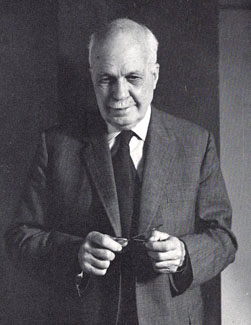| Lawrence Bragg  AKA William Lawrence Bragg AKA William Lawrence Bragg
Born: 31-Mar-1890
Birthplace: Adelaide, South Australia, Australia
Died: 1-Jul-1971
Location of death: Ipswich, Suffolk, England
Cause of death: unspecified
Remains: Buried, Trinity College Chapel, Cambridge University, England
Gender: Male
Race or Ethnicity: White
Sexual orientation: Straight
Occupation: Physicist Nationality: Australia
Executive summary: Bragg's Law of diffraction Military service: British Royal Horse Artillery (1915-19, to Major) Physicist Lawrence Bragg studied under J. J. Thomson and was the son of physicist William Bragg. Building on Max von Laue's pioneering work in x-ray crystallography, he proposed in 1912 what is now called Bragg's law of diffraction, which explains how crystals diffract X-ray beams at specific angles of incidence. They theorized that the molecular structure of a crystal could be ascertained from observing and analyzing the x-ray interference pattern, and to prove their assertion they designed an X-ray spectrometer and devised a mathematical system for analyzing its data. For this work and their landmark 1915 book on the topic, X-rays and Crystal Structure, the father-and-son team shared that year's Nobel Prize for Physics.
25 years of age when he won the honor, Bragg was and remains the youngest Nobel laureate in history. He was also awarded the Military Cross during World War I, for his work developing technology to pinpoint the position of enemy artillery by analyzing the sound of their weapons firing. He later studied metallurgy, silicates, and the structure of proteins. At the start of his career atomic theory had only recently been accepted, and examining the behavior of individual atoms seemed like science fiction; toward the end of his career he was the director of Cavendish Laboratory at Cambridge University in the 1950s, as Francis Crick and James Watson used technology largely built on x-ray methodology developed by Bragg and his father to unravel the structure of deoxyribonucleic acid (DNA). Father: William Henry Bragg (physicist)
Mother: Gwendoline Todd Bragg (artist, b. 1869, m. 1889, d. 1929)
Brother: Robert Charles Bragg (d. 2-Sep-1915 World War I)
Sister: Gwendoline Bragg Caroe (b. circa 1907)
Wife: Alice Grace Jenny Hopkinson Bragg (m. 1921, four children)
Son: David William Bragg (engineer)
Daughter: Margaret Alice Bragg
Daughter: Patience Mary Bragg
Son: Stephen Lawrence Bragg (engineer)
High School: St. Peter's College, Adelaide, Australia (1904)
University: BS Mathematics, University of Adelaide (1908)
University: MA Physics, Trinity College, Cambridge University (1911)
Professor: Langworthy Professor of Physics, Victoria University of Manchester (1919-37)
Professor: Cavendish Professor of Physics, Cambridge University (1938-53)
Administrator: Cavendish Laboratory, Cambridge University (1938-53)
Nobel Prize for Physics 1915 (with William Bragg)
Matteucci Medal 1915 (with William Bragg)
Military Cross 1918
Officer of the British Empire 1918
Hughes Medal 1931
Royal Medal 1946
Knight of the British Empire 1941
Roebling Medal 1948
Copley Medal 1966
Order of the Companions of Honour 1967
Royal Institution of Great Britain Director (1953-61)
Royal Society 1921
Royal Society of Edinburgh
U.K. National Physical Laboratory Director (1937-38)
Australian Ancestry
English Ancestry
Appears on the cover of:
Time, 3-Oct-1938, DETAILS: Science, BYLINE: Fifth Director (of Cavendish Lab)
Author of books:
X Rays and Crystal Structure (1915, non-fiction, with William Bragg)
The Structure of Silicates (1930, non-fiction)
The Crystalline State (1934, non-fiction)
Electricity (1936, non-fiction)
Atomic Structure of Minerals (1937, non-fiction)
Requires Flash 7+ and Javascript.
Do you know something we don't?
Submit a correction or make a comment about this profile
Copyright ©2019 Soylent Communications
|